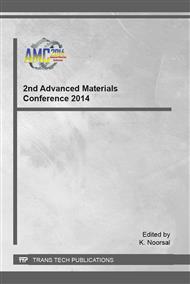[1]
Y. Ievskaya, Fabrication of ZnO/Cu2O heterojunctions in atmospheric conditions: Improved interface quality and solar cell performance, Solar Energy Materials and Solar Cells.
DOI: 10.1016/j.solmat.2014.09.018
Google Scholar
[2]
I. Y. Y. Bu, Novel all solution processed heterojunction using p-type cupric oxide and n-type zinc oxide nanowires for solar cell applications, Ceramics International 39 (2013) 8073-8078.
DOI: 10.1016/j.ceramint.2013.03.079
Google Scholar
[3]
H. -y. Wang and C. -g. Fan, Copper oxide nanostructures: Controlled synthesis and their catalytic performance, Solid State Sciences 16 (2013) 130-133.
DOI: 10.1016/j.solidstatesciences.2012.11.009
Google Scholar
[4]
Y. -e. Gu, Preparation of flower-like Cu2O nanoparticles by pulse electrodeposition and their electrocatalytic application, Applied Surface Science 256 (2010) 5862-5866.
DOI: 10.1016/j.apsusc.2010.03.065
Google Scholar
[5]
D. Gopalakrishna, Effect of annealing on the properties of nanostructured CuO thin films for enhanced ethanol sensitivity, Ceramics International 39 (2013) 7685-7691.
DOI: 10.1016/j.ceramint.2013.03.021
Google Scholar
[6]
V. R. Katti, Mechanism of drifts in H2S sensing properties of SnO2: CuO composite thin film sensors prepared by thermal evaporation, Sensors and Actuators B: Chemical 96 (2003) 245-252.
DOI: 10.1016/s0925-4005(03)00532-x
Google Scholar
[7]
F. A. Akgul, Influence of thermal annealing on microstructural, morphological, optical properties and surface electronic structure of copper oxide thin films, Materials Chemistry and Physics 147 (2014) 987-995.
DOI: 10.1016/j.matchemphys.2014.06.047
Google Scholar
[8]
S. K. Maji, Chemical synthesis of mesoporous CuO from a single precursor: Structural, optical and electrical properties, Journal of Solid State Chemistry 183 (2010) 1900-(1904).
DOI: 10.1016/j.jssc.2010.06.007
Google Scholar
[9]
J. K. Feng, Electrochemical performance of CuO nanocrystal film fabricated by room temperature sputtering, Materials Research Bulletin 46 (2011) 424-427.
DOI: 10.1016/j.materresbull.2010.12.006
Google Scholar
[10]
F. M. Li, Low temperature (< 100° C) deposited P-type cuprous oxide thin films: Importance of controlled oxygen and deposition energy, Thin Solid Films 520 (2011) 1278-1284.
DOI: 10.1016/j.tsf.2011.04.192
Google Scholar
[11]
K. Khojier and A. Behju, Annealing temperature effect on nanostructure and phase transition of Copper Oxide thin films, International Journal of Nano Dimension (IJND) (2012).
Google Scholar
[12]
F. Teng, Synthesis of flower-like CuO nanostructures as a sensitive sensor for catalysis, Sensors and Actuators B: Chemical 134 (2008) 761-768.
DOI: 10.1016/j.snb.2008.06.023
Google Scholar
[13]
K. U. Isah, Effect of oxidation temperature on the properties of copper oxide thin films prepared from thermally oxidised evaporated copper thin films.
Google Scholar
[14]
Q. Zhang, CuO nanostructures: Synthesis, characterization, growth mechanisms, fundamental properties, and applications, Progress in Materials Science 60 (2014) 208-337.
DOI: 10.1016/j.pmatsci.2013.09.003
Google Scholar
[15]
R. Motoyoshi, Fabrication and characterization of cuprous oxide: fullerene solar cells, Synthetic metals 160 (2010) 1219-1222.
DOI: 10.1016/j.synthmet.2010.03.012
Google Scholar
[16]
M. Muhibbullah, M. Ichimura, Fabrication of copper oxide thin films by the drop chemical deposition technique, Materials Research Bulletin 47 (2012) 1968-(1972).
DOI: 10.1016/j.materresbull.2012.04.013
Google Scholar


